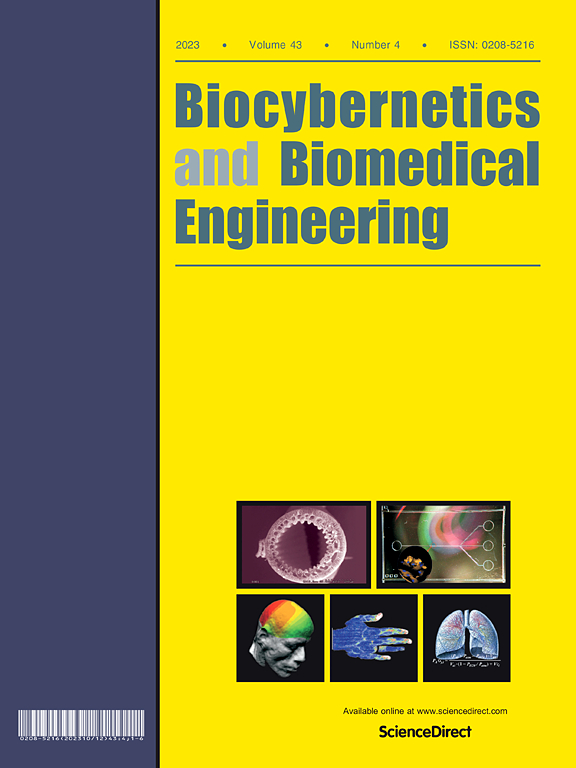视神经头生物力学的粘弹性建模:眼内和脑脊液压力的影响
IF 6.6
2区 医学
Q1 ENGINEERING, BIOMEDICAL
引用次数: 0
摘要
尽管视神经头(ONH)对眼内压(IOP)的变化表现出明显的粘弹性反应,但现有的ONH生物力学计算模型尚未充分考虑这些粘弹性特性。在这项研究中,我们引入并评估了一种无网格的梁-固耦合算法来模拟粘弹性巩膜基质中各向异性胶原纤维的复杂粘弹性行为。我们还结合了视网膜、筛板和视神经的粘弹性配方,以提供对ONH组织力学更全面的了解。我们使用人眼特定的后眼有限元模型比较了超弹性和粘弹性巩膜材料配方造成的ONH的生物力学。该模型集成了承载筛层的详细三维微观结构,包括分散的层状神经组织,以及胶原巩膜和瞳孔的异质性、各向异性行为。粘弹性材料的性能被验证针对发表的实验拉伸测试人类巩膜和视网膜组织样本。在250 ms的时间内,通过应用体位转换(如从坐姿到仰卧位)时典型的IOP和脑脊液压(CSFP)的变化来模拟ONH的生物力学反应。在两种模拟中,与预期的那样,与坐着相比,仰卧位的ONH组织表现出更大的应力和应变。在超弹性材料模型中,从坐姿到仰卧的过渡过程中,层流表面呈现后侧变形(+6µm),而在粘弹性材料模型中,层流表面呈现前侧变形(−5.7µm)。此外,与超弹性配方(19.8µm)相比,粘弹性配方(9µm)在前椎板止点处的径向巩膜管扩张明显更小。所有结果与实验观察结果一致。虽然两种模型的应力、应变和变形都保持在生理范围内,但两种配方之间存在实质性差异,特别是在变形方面。提高ONH模型中材料配方的准确性有望增强我们对ONH生物力学的理解。然而,这些结果需要进一步的实验验证,并增强其适用性。本文章由计算机程序翻译,如有差异,请以英文原文为准。
Viscoelastic modeling of optic nerve head biomechanics: Effects of intraocular and cerebrospinal fluid pressure
Although the optic nerve head (ONH) has demonstrated a significant viscoelastic response to changes in intraocular pressure (IOP), existing computational models of ONH biomechanics have yet to fully account for these viscoelastic properties. In this study, we introduce and evaluate a mesh-free beam-in-solid coupling algorithm to model the complex viscoelastic behavior of anisotropic collagen fibers within a viscoelastic scleral matrix. We also incorporated viscoelastic formulations for the retina, lamina cribrosa, and optic nerve to provide a more comprehensive understanding of ONH tissue mechanics. We compared the biomechanics of the ONH resulting from hyperelastic and viscoelastic scleral material formulations using an eye-specific finite element model of the posterior human eye. This model integrates the detailed 3D microstructure of the load-bearing lamina cribrosa, including interspersed laminar neural tissues, as well as the heterogeneous, anisotropic behavior of the collagenous sclera and pia. The viscoelastic material properties were validated against published experimental tensile tests of human scleral and retinal tissue samples. Simulations of ONH biomechanical responses were conducted by applying changes in IOP and cerebrospinal fluid pressure (CSFP) typical of body position transitions, such as moving from sitting to supine, over a 250 ms period. In both simulations, the ONH tissues exhibited greater stresses and strains in the supine position compared to sitting, as anticipated. The laminar surface showed posterior deformation (+6 µm) during the transition from sitting to supine when using the hyperelastic material model, whereas it deformed anteriorly (−5.7 µm) with the viscoelastic model. Furthermore, the radial scleral canal expansion at the anterior laminar insertion was significantly smaller in the viscoelastic formulation (9 µm) compared to the hyperelastic formulation (19.8 µm). All results aligned with experimental observations. While the stresses, strains, and deformations remained within physiological ranges for both models, there were substantial differences between the two formulations, particularly in terms of deformation. Improving the accuracy of material formulations in ONH models is expected to enhance our understanding of ONH biomechanics. However, further experimental validation is needed to confirm these results and strengthen their applicability.
求助全文
通过发布文献求助,成功后即可免费获取论文全文。
去求助
来源期刊

Biocybernetics and Biomedical Engineering
ENGINEERING, BIOMEDICAL-
CiteScore
16.50
自引率
6.20%
发文量
77
审稿时长
38 days
期刊介绍:
Biocybernetics and Biomedical Engineering is a quarterly journal, founded in 1981, devoted to publishing the results of original, innovative and creative research investigations in the field of Biocybernetics and biomedical engineering, which bridges mathematical, physical, chemical and engineering methods and technology to analyse physiological processes in living organisms as well as to develop methods, devices and systems used in biology and medicine, mainly in medical diagnosis, monitoring systems and therapy. The Journal''s mission is to advance scientific discovery into new or improved standards of care, and promotion a wide-ranging exchange between science and its application to humans.
 求助内容:
求助内容: 应助结果提醒方式:
应助结果提醒方式:


